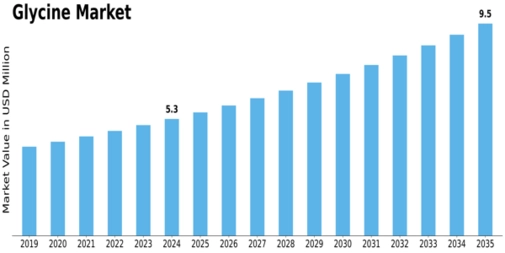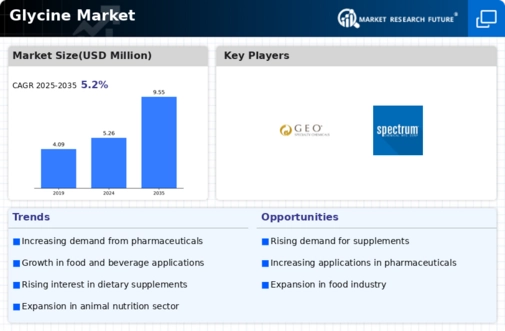-
EXECUTIVE SUMMARY
-
GLOBAL GLYCINE MARKET, BY GRADE
-
GLOBAL GLYCINE MARKET, BY APPLICATION
-
GLOBAL GLYCINE MARKET, BY END-USERS
-
GLOBAL GLYCINE MARKET, BY REGION
-
MARKET INTRODUCTION
-
DEFINITION
-
SCOPE OF THE STUDY
-
MARKET STRUCTURE
-
KEY BUYING CRITERIA
-
RESEARCH METHODOLOGY
-
RESEARCH PROCESS
-
PRIMARY RESEARCH
-
SECONDARY RESEARCH
-
MARKET SIZE ESTIMATION
-
TOP DOWN & BOTTOM-UP APPROACH
-
FORECAST MODEL
-
LIST OF ASSUMPTIONS
-
MARKET DYNAMICS
-
INTRODUCTION
-
DRIVERS
- GROWING DEMAND FOR SUSTAINABLE PRODUCTS
- EXPANDING PHARMACEUTICAL INDUSTRY
- DRIVERS IMPACT ANALYSIS
-
RESTRAINTS
- FLUCTUATIONS IN THE PRICES OF RAW MATERIALS
- RESTRAINTS IMPACT ANALYSIS
-
OPPORTUNITIES
- TECHNOLOGICAL ADVANCEMENTS IN PRODUCTION
-
IMPACT OF COVID-19 ON GLOBAL GLYCINE MARKET
-
IMPACT OF COVID-19 ON THE GLOBAL GLYCINE MARKET
-
SUPPLY CHAIN IMPACT
- IMPACT ON MANUFACTURER/DEVELOPER
- IMPACT ON COMPONENT/SERVICES SUPPLIER
- IMPACT ON DISTRIBUTION/LOGISTICS
-
MARKET FACTOR ANALYSIS
-
SUPPLY/VALUE CHAIN ANALYSIS
- RAW MATERIALS AND COMPONENTS SUPPLIERS
- MANUFACTURING & ASSEMBLY
- DISTRIBUTION & SALES
- RETAILERS AND END-USERS
-
PORTER’S FIVE FORCES MODEL
- THREAT OF NEW ENTRANTS
- BARGAINING POWER OF SUPPLIERS
- BARGAINING POWER OF BUYERS
- THREAT OF SUBSTITUTES
- INTENSITY OF RIVALRY
-
GLOBAL GLYCINE MARKET, BY GRADE
-
OVERVIEW
-
GLOBAL GLYCINE MARKET SIZE, MARKET ESTIMATES & FORECAST BY GRADE, 2019-2032
- GLOBAL GLYCINE MARKET SIZE: MARKET ESTIMATES & FORECAST BY GRADE, 2019-2032
-
GLOBAL GLYCINE MARKET, BY APPLICATION
-
OVERVIEW
-
GLOBAL GLYCINE MARKET SIZE, MARKET ESTIMATES & FORECAST BY APPLICATION, 2019-2032
- GLOBAL GLYCINE MARKET SIZE: MARKET ESTIMATES & FORECAST BY APPLICATION, 2019-2032
-
GLOBAL GLYCINE MARKET, BY END-USERS
-
OVERVIEW
-
GLOBAL GLYCINE MARKET SIZE, MARKET ESTIMATES & FORECAST BY END-USERS, 2019-2032
- GLOBAL GLYCINE MARKET SIZE: MARKET ESTIMATES & FORECAST BY END-USERS, 2019-2032
-
GLOBAL GLYCINE MARKET, BY REGION
-
OVERVIEW
-
NORTH AMERICA
- U.S.
- CANADA
- MEXICO
-
EUROPE
- GERMANY
- UK
- FRANCE
- RUSSIA
- ITALY
- SPAIN
- REST OF EUROPE
-
ASIA PACIFIC
- CHINA
- INDIA
- JAPAN
- SOUTH KOREA
- REST OF ASIA PACIFIC
-
LATIN AMERICA
- BRAZIL
- ARGENTINA
- REST OF LATIN AMERICA
-
MIDDLE EAST & AFRICA
- SAUDI ARABIA
- SOUTH AFRICA
- REST OF THE MIDDLE EAST & AFRICA
-
COMPETITIVE LANDSCAPE
-
COMPETITIVE OVERVIEW
-
COMPETITIVE BENCHMARKING
-
MAJOR PLAYERS IN THE GLOBAL GLYCINE MARKET
-
LEADING PLAYERS IN TERMS OF THE NUMBER OF DEVELOPMENTS IN THE GLOBAL GLYCINE MARKET
-
KEY DEVELOPMENTS & GROWTH STRATEGIES
- PRODUCT LAUNCH/PRODUCT DEVELOPMENT/APPROVAL
- ACQUISITION/PARTNERSHIP
-
COMPANY PROFILES
-
SPECTRUM CHEMICAL
- COMPANY OVERVIEW
- FINANCIAL OVERVIEW
- PRODUCTS OFFERED
- KEY DEVELOPMENTS
- SWOT ANALYSIS
- KEY STRATEGIES
-
RESONAC HOLDINGS CORPORATION
- COMPANY OVERVIEW
- FINANCIAL OVERVIEW
- PRODUCTS OFFERED
- KEY DEVELOPMENTS
- SWOT ANALYSIS
- KEY STRATEGIES
-
AJINOMOTO CO., INC.
- COMPANY OVERVIEW
- FINANCIAL OVERVIEW
- PRODUCTS OFFERED
- KEY DEVELOPMENTS
- SWOT ANALYSIS
- KEY STRATEGIES
-
CHATTEM CHEMICALS, INC
- COMPANY OVERVIEW
- FINANCIAL OVERVIEW
- PRODUCTS/SERVICES OFFERED
- KEY DEVELOPMENTS
- SWOT ANALYSIS
- KEY STRATEGIES
-
EVONIK
- COMPANY OVERVIEW
- FINANCIAL OVERVIEW
- PRODUCTS/SERVICES OFFERED
- KEY DEVELOPMENTS
- SWOT ANALYSIS
- KEY STRATEGIES
-
SISCO RESEARCH LABORATORIES PVT. LTD.
- COMPANY OVERVIEW
- FINANCIAL OVERVIEW
- PRODUCTS/SERVICES OFFERED
- KEY DEVELOPMENTS
- SWOT ANALYSIS
- KEY STRATEGIES
-
SHIJIAZHUANG DONGHUA JINLONG CHEMICAL CO., LTD.
- COMPANY OVERVIEW
- FINANCIAL OVERVIEW
- PRODUCTS/SERVICES OFFERED
- KEY DEVELOPMENTS
- SWOT ANALYSIS
- KEY STRATEGIES
-
YUKI GOSEI KOGYO CO., LTD.
- COMPANY OVERVIEW
- FINANCIAL OVERVIEW
- PRODUCTS OFFERED
- KEY DEVELOPMENTS
- SWOT ANALYSIS
- KEY STRATEGIES
-
FOODCHEM INTERNATIONAL CORPORATION
- COMPANY OVERVIEW
- FINANCIAL OVERVIEW
- PRODUCTS OFFERED
- KEY DEVELOPMENTS
- SWOT ANALYSIS
- KEY STRATEGIES
-
VIZAG CHEMICALS
- COMPANY OVERVIEW
- FINANCIAL OVERVIEW
- PRODUCTS OFFERED
- KEY DEVELOPMENTS
- SWOT ANALYSIS
- KEY STRATEGIES
-
APPENDIX
-
REFERENCES
-
-
LIST OF TABLES
-
LIST OF ASSUMPTIONS
-
GLOBAL GLYCINE MARKET SIZE ESTIMATES & FORECAST, BY GRADE, 2019-2032 (USD MILLION)
-
GLOBAL GLYCINE MARKET SIZE ESTIMATES & FORECAST, BY APPLICATION, 2019-2032 (USD MILLION)
-
GLOBAL GLYCINE MARKET SIZE ESTIMATES & FORECAST, BY END-USERS, 2019-2032 (USD MILLION)
-
GLOBAL GLYCINE MARKET SIZE, BY REGION, 2019-2032 (USD MILLION)
-
NORTH AMERICA: GLYCINE MARKET SIZE, BY COUNTRY, 2019-2032 (USD MILLION)
-
NORTH AMERICA GLYCINE MARKET SIZE ESTIMATES & FORECAST, BY GRADE, 2019-2032 (USD MILLION)
-
NORTH AMERICA GLYCINE MARKET SIZE ESTIMATES & FORECAST, BY APPLICATION, 2019-2032 (USD MILLION)
-
NORTH AMERICA GLYCINE MARKET SIZE ESTIMATES & FORECAST, BY END-USERS, 2019-2032 (USD MILLION)
-
US GLYCINE MARKET SIZE ESTIMATES & FORECAST, BY GRADE, 2019-2032 (USD MILLION)
-
US GLYCINE MARKET SIZE ESTIMATES & FORECAST, BY APPLICATION, 2019-2032 (USD MILLION)
-
US GLYCINE MARKET SIZE ESTIMATES & FORECAST, BY END-USERS, 2019-2032 (USD MILLION)
-
CANADA GLYCINE MARKET SIZE ESTIMATES & FORECAST, BY GRADE, 2019-2032 (USD MILLION)
-
CANADA GLYCINE MARKET SIZE ESTIMATES & FORECAST, BY APPLICATION, 2019-2032 (USD MILLION)
-
CANADA GLYCINE MARKET SIZE ESTIMATES & FORECAST, BY END-USERS, 2019-2032 (USD MILLION)
-
EUROPE: GLYCINE MARKET SIZE, BY COUNTRY, 2019-2032 (USD MILLION)
-
EUROPE GLYCINE MARKET SIZE ESTIMATES & FORECAST, BY GRADE, 2019-2032 (USD MILLION)
-
EUROPE GLYCINE MARKET SIZE ESTIMATES & FORECAST, BY APPLICATION, 2019-2032 (USD MILLION)
-
EUROPE GLYCINE MARKET SIZE ESTIMATES & FORECAST, BY END-USERS, 2019-2032 (USD MILLION)
-
GERMANY GLYCINE MARKET SIZE ESTIMATES & FORECAST, BY GRADE, 2019-2032 (USD MILLION)
-
GERMANY GLYCINE MARKET SIZE ESTIMATES & FORECAST, BY APPLICATION, 2019-2032 (USD MILLION)
-
GERMANY GLYCINE MARKET SIZE ESTIMATES & FORECAST, BY END-USERS, 2019-2032 (USD MILLION)
-
UK GLYCINE MARKET SIZE ESTIMATES & FORECAST, BY GRADE, 2019-2032 (USD MILLION)
-
UK GLYCINE MARKET SIZE ESTIMATES & FORECAST, BY APPLICATION, 2019-2032 (USD MILLION)
-
UK GLYCINE MARKET SIZE ESTIMATES & FORECAST, BY END-USERS, 2019-2032 (USD MILLION)
-
FRANCE GLYCINE MARKET SIZE ESTIMATES & FORECAST, BY GRADE, 2019-2032 (USD MILLION)
-
FRANCE GLYCINE MARKET SIZE ESTIMATES & FORECAST, BY APPLICATION, 2019-2032 (USD MILLION)
-
FRANCE GLYCINE MARKET SIZE ESTIMATES & FORECAST, BY END-USERS, 2019-2032 (USD MILLION)
-
RUSSIA GLYCINE MARKET SIZE ESTIMATES & FORECAST, BY GRADE, 2019-2032 (USD MILLION)
-
RUSSIA GLYCINE MARKET SIZE ESTIMATES & FORECAST, BY APPLICATION, 2019-2032 (USD MILLION)
-
RUSSIA GLYCINE MARKET SIZE ESTIMATES & FORECAST, BY END-USERS, 2019-2032 (USD MILLION) END-USERS
-
ITALY GLYCINE MARKET SIZE ESTIMATES & FORECAST, BY GRADE, 2019-2032 (USD MILLION)
-
ITALY GLYCINE MARKET SIZE ESTIMATES & FORECAST, BY APPLICATION, 2019-2032 (USD MILLION)
-
ITALY GLYCINE MARKET SIZE ESTIMATES & FORECAST, BY END-USERS, 2019-2032 (USD MILLION)
-
SPAIN GLYCINE MARKET SIZE ESTIMATES & FORECAST, BY GRADE, 2019-2032 (USD MILLION)
-
SPAIN GLYCINE MARKET SIZE ESTIMATES & FORECAST, BY APPLICATION, 2019-2032 (USD MILLION)
-
SPAIN GLYCINE MARKET SIZE ESTIMATES & FORECAST, BY END-USERS, 2019-2032 (USD MILLION)
-
REST OF EUROPE GLYCINE MARKET SIZE ESTIMATES & FORECAST, BY GRADE, 2019-2032 (USD MILLION)
-
REST OF EUROPE GLYCINE MARKET SIZE ESTIMATES & FORECAST, BY APPLICATION, 2019-2032 (USD MILLION)
-
REST OF EUROPE GLYCINE MARKET SIZE ESTIMATES & FORECAST, BY END-USERS, 2019-2032 (USD MILLION)
-
ASIA PACIFIC: GLYCINE MARKET SIZE, BY COUNTRY, 2019-2032 (USD MILLION)
-
ASIA PACIFIC GLYCINE MARKET SIZE ESTIMATES & FORECAST, BY GRADE, 2019-2032 (USD MILLION)
-
ASIA PACIFIC GLYCINE MARKET SIZE ESTIMATES & FORECAST, BY APPLICATION, 2019-2032 (USD MILLION)
-
ASIA PACIFIC GLYCINE MARKET SIZE ESTIMATES & FORECAST, BY END-USERS, 2019-2032 (USD MILLION)
-
CHINA GLYCINE MARKET SIZE ESTIMATES & FORECAST, BY GRADE, 2019-2032 (USD MILLION)
-
CHINA GLYCINE MARKET SIZE ESTIMATES & FORECAST, BY APPLICATION, 2019-2032 (USD MILLION)
-
CHINA GLYCINE MARKET SIZE ESTIMATES & FORECAST, BY END-USERS, 2019-2032 (USD MILLION)
-
INDIA GLYCINE MARKET SIZE ESTIMATES & FORECAST, BY GRADE, 2019-2032 (USD MILLION)
-
INDIA GLYCINE MARKET SIZE ESTIMATES & FORECAST, BY APPLICATION, 2019-2032 (USD MILLION)
-
INDIA GLYCINE MARKET SIZE ESTIMATES & FORECAST, BY END-USERS, 2019-2032 (USD MILLION)
-
JAPAN GLYCINE MARKET SIZE ESTIMATES & FORECAST, BY GRADE, 2019-2032 (USD MILLION)
-
JAPAN GLYCINE MARKET SIZE ESTIMATES & FORECAST, BY APPLICATION, 2019-2032 (USD MILLION)
-
JAPAN GLYCINE MARKET SIZE ESTIMATES & FORECAST, BY END-USERS, 2019-2032 (USD MILLION)
-
SOUTH KOREA GLYCINE MARKET SIZE ESTIMATES & FORECAST, BY GRADE, 2019-2032 (USD MILLION)
-
SOUTH KOREA GLYCINE MARKET SIZE ESTIMATES & FORECAST, BY APPLICATION, 2019-2032 (USD MILLION)
-
SOUTH KOREA GLYCINE MARKET SIZE ESTIMATES & FORECAST, BY END-USERS, 2019-2032 (USD MILLION)
-
REST OF ASIA PACIFIC GLYCINE MARKET SIZE ESTIMATES & FORECAST, BY GRADE, 2019-2032 (USD MILLION)
-
REST OF ASIA PACIFIC GLYCINE MARKET SIZE ESTIMATES & FORECAST, BY APPLICATION, 2019-2032 (USD MILLION)
-
REST OF ASIA PACIFIC GLYCINE MARKET SIZE ESTIMATES & FORECAST, BY END-USERS, 2019-2032 (USD MILLION)
-
LATIN AMERICA: GLYCINE MARKET SIZE, BY COUNTRY, 2019-2032 (USD MILLION)
-
LATIN AMERICA GLYCINE MARKET SIZE ESTIMATES & FORECAST, BY GRADE, 2019-2032 (USD MILLION)
-
LATIN AMERICA GLYCINE MARKET SIZE ESTIMATES & FORECAST, BY APPLICATION, 2019-2032 (USD MILLION)
-
LATIN AMERICA GLYCINE MARKET SIZE ESTIMATES & FORECAST, BY END-USERS, 2019-2032 (USD MILLION)
-
BRAZIL GLYCINE MARKET SIZE ESTIMATES & FORECAST, BY GRADE, 2019-2032 (USD MILLION)
-
BRAZIL GLYCINE MARKET SIZE ESTIMATES & FORECAST, BY APPLICATION, 2019-2032 (USD MILLION)
-
BRAZIL GLYCINE MARKET SIZE ESTIMATES & FORECAST, BY END-USERS, 2019-2032 (USD MILLION)
-
MEXICO GLYCINE MARKET SIZE ESTIMATES & FORECAST, BY GRADE, 2019-2032 (USD MILLION)
-
MEXICO GLYCINE MARKET SIZE ESTIMATES & FORECAST, BY APPLICATION, 2019-2032 (USD MILLION)
-
MEXICO GLYCINE MARKET SIZE ESTIMATES & FORECAST, BY END-USERS, 2019-2032 (USD MILLION)
-
ARGENTINA GLYCINE MARKET SIZE ESTIMATES & FORECAST, BY GRADE, 2019-2032 (USD MILLION)
-
ARGENTINA GLYCINE MARKET SIZE ESTIMATES & FORECAST, BY APPLICATION, 2019-2032 (USD MILLION)
-
ARGENTINA GLYCINE MARKET SIZE ESTIMATES & FORECAST, BY END-USERS, 2019-2032 (USD MILLION)
-
REST OF LATIN AMERICA GLYCINE MARKET SIZE ESTIMATES & FORECAST, BY GRADE, 2019-2032 (USD MILLION)
-
REST OF LATIN AMERICA GLYCINE MARKET SIZE ESTIMATES & FORECAST, BY APPLICATION, 2019-2032 (USD MILLION)
-
REST OF LATIN AMERICA GLYCINE MARKET SIZE ESTIMATES & FORECAST, BY END-USERS, 2019-2032 (USD MILLION)
-
MIDDLE EAST & AFRICA: GLYCINE MARKET SIZE, BY COUNTRY, 2019-2032 (USD MILLION)
-
MIDDLE EAST & AFRICA GLYCINE MARKET SIZE ESTIMATES & FORECAST, BY GRADE, 2019-2032 (USD MILLION)
-
MIDDLE EAST & AFRICA GLYCINE MARKET SIZE ESTIMATES & FORECAST, BY APPLICATION, 2019-2032 (USD MILLION)
-
MIDDLE EAST & AFRICA GLYCINE MARKET SIZE ESTIMATES & FORECAST, BY END-USERS, 2019-2032 (USD MILLION)
-
GCC COUNTRIES GLYCINE MARKET SIZE ESTIMATES & FORECAST, BY GRADE, 2019-2032 (USD MILLION)
-
GCC COUNTRIES GLYCINE MARKET SIZE ESTIMATES & FORECAST, BY APPLICATION, 2019-2032 (USD MILLION)
-
GCC COUNTRIES GLYCINE MARKET SIZE ESTIMATES & FORECAST, BY END-USERS, 2019-2032 (USD MILLION)
-
SOUTH AFRICA GLYCINE MARKET SIZE ESTIMATES & FORECAST, BY GRADE, 2019-2032 (USD MILLION)
-
SOUTH AFRICA GLYCINE MARKET SIZE ESTIMATES & FORECAST, BY APPLICATION, 2019-2032 (USD MILLION)
-
SOUTH AFRICA GLYCINE MARKET SIZE ESTIMATES & FORECAST, BY END-USERS, 2019-2032 (USD MILLION)
-
REST OF MIDDLE EAST & AFRICA GLYCINE MARKET SIZE ESTIMATES & FORECAST, BY GRADE, 2019-2032 (USD MILLION)
-
REST OF MIDDLE EAST & AFRICA GLYCINE MARKET SIZE ESTIMATES & FORECAST, BY APPLICATION, 2019-2032 (USD MILLION)
-
REST OF MIDDLE EAST & AFRICA GLYCINE MARKET SIZE ESTIMATES & FORECAST, BY END-USERS, 2019-2032 (USD MILLION)
-
MAJOR PLAYERS IN THE GLOBAL GLYCINE MARKET
-
THE MOST ACTIVE PLAYERS IN THE GLOBAL GLYCINE MARKET
-
PRODUCT LAUNCH/PRODUCT DEVELOPMENT/APPROVAL
-
ACQUISITION/ PARTNERSHIP
-
SPECTRUM CHEMICAL: PRODUCTS OFFERED
-
SPECTRUM CHEMICAL: KEY DEVELOPMENTS
-
RESONAC HOLDINGS CORPORATION: PRODUCTS OFFERED
-
AJINOMOTO CO., INC.: PRODUCTS OFFERED
-
CHATTEM CHEMICALS, INC: PRODUCTS/SERVICES OFFERED
-
TA






Leave a Comment